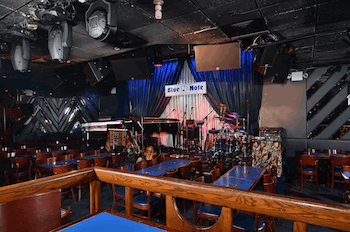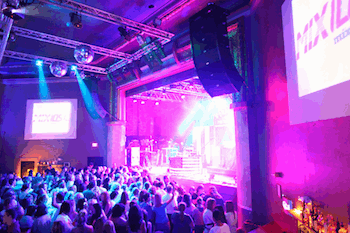With Pleasure

So a guy walks into a bar—and what he sees are lots of flat screens, zoned areas specific to the various tastes and desires of patrons, and a bevy of interactive options.In a bad economy, bars tend to do well; they’re places to escape. And many clients are trying to draw in customers by improving their venues, said Jonathan Joyce, partner, with Jak Daragjati, JD Systems of Staten Island, NY. “The newer venues are ultra-lounges, a mix of the bar/club/lounge environment, with a lower music volume than a nightclub. Sports bars are also exploding, and with immersive tech, everyone wants to be connected to the outside world.”

- Since opening its doors in 1981, the Blue Note in New York City has become one of the premier jazz clubs in the world. Recently the club received an upgraded SLS Audio sound system driven by Yamaha TX4n amps and installed by Peltrix. The Blue Note bought one of the first five Yamaha M7CL digital consoles to arrive in the U.S. and upgraded with a new M7CL integrated with Yamaha’s StageMix iPad app.
- Owners of established restaurants and bars have realized the need to update, he said. “We’re seeing a 50/50 split in our business between new construction and remodeling projects which are often close to new construction because of extensive revamping. An example is a recent project in Morristown, NJ where a nightclub was flipped into sports bar now called Uptown. It was once a dark club and now has 40 TVs, a 131-inch high-definition projection screen, and internet kiosks for patrons to check on their fantasy football.”
Professional-grade HD projection systems, internet-based music sources, and distributed audio systems are all becoming increasingly relevant to the hospitality industry, observed Orin Knopp, president of Presentation Products in New York, NY. “At the core of a professional audiovisual solution is a distributed audio system which delivers music to areas throughout the property from sources located at an audiovisual head end,” he said. “This type of distributed audio system is designed by dividing property areas into zones and sub-zones, determined by evaluating the function, architectural layout, and acoustical properties of each space.”
Audio zones are areas that play the same source throughout the space. Audio sub-zones are smaller areas within each zone for which volume can be independently adjusted. Sub-zone division also allows the audio designer to select speakers that best suit the acoustical properties and architectural features of a space. “Proper audio zone layout is extremely important to ensure that guests and residents experience high-quality, intelligible, consistent, and continuous audio as they move through the property,” Knopp explained.
This shift to zones is a result of a move away from the global, all-encompassing sound and video to more focused individualized thinking as far as what can or can’t be done in these venues, said Rod Andrewson, manager of engineering for CCS Presentation Systems of Scottsdale, AZ. “We’re being asked to design areas or zones that can be modified for particular hospitality customers such as those in sports, news, or in the financial industry.”
Bars and restaurants no longer want to be pigeonholed as just a sports bar or a club catering to 20-aomethings; they’re trying to be meeting places for a variety of customers, he said. “[Clients want] more flexibility in managing spaces such as in projects that allow the audio source to be appropriate for the customer, i.e., with wireless on tables so customers can select what they want to hear and see.”
Andrewson also noted a move away from a low-dollar mentality. “For instance, one CCS client, a national chain of bars and grills, has chosen to open new locations based on the local clientele, and they want more of these private zoned areas. In this economy, they’re concerned with creating an environment to capture a larger market share. The desire for that zone-specific flexibility creates the need for more complicated systems for us to design and install.”
This is where innovations come into play. Some manufacturers have seen the writing on the wall, he said, making the move to IP-based AV, which has made flexible systems more affordable and easily available. “We still see huge value in older tech such as CobraNet and Dante, but the AVB standard is moving in and manufacturers are building it into the products. There is also a big push to move toward IP video as well as a retro movement to go back to expand coax. We can send HD over a coax backbone more affordably.”
A daily selection of the top stories for AV integrators, resellers and consultants. Sign up below.

The Beacham was Orlando's first South Beach-style VIP nightclub when it opened in 1999 in a historic venue built in the the early 1920s. Now it has been restored as a live performance venue featuring a KF740 PA system from EAW.For many of its hospitality projects, JD Systems is working with the BSS BLU-100, with multiple inputs, outputs, and zone control. “It will do anything and replaces the need for a rack full of audio components,” Joyce explained. “We can control everything digitally in the virtual world including EQs, compression, and mixers. It’s remotely managed and ties seamlessly into control systems like Crestron. That’s trimmed down our cabling needs and keeps things more compact and cleaner.”
In addition, many speaker innovations are at play in this sector. “We use JBL and they are constantly coming out with new product to help with installations,” he said. “For example, in a Staten Island restaurant/ultra-lounge project called Z TWO, we installed JBL’s Control 47 with RBI technology.”
CCS is currently engaged in projects for four casinos, Andrewson said. “They have the same requirements as other hospitality clients; they want their customers to feel comfortable no matter what their interest. They’re looking for quality. Four years ago, casino clients were not concerned with high–end commercial flat panels. Now, they want value in higher-end, higher-performing products. They’re looking at lower revenues and they want to recapture revenue from the support and maintenance end as well as from the customer base.”
Typically, he said, casinos use hundreds of plasmas and they want to use less energy. “They don’t always understand that with 103-inch plasmas mounted on a wall over the bar or gaming tables, for example, that taking those screens off the wall for repair or maintenance means downtime and loss of revenue. We recently did a project for the Talking Stick Resort Hotel, Spa & Casino, for the Salt River Pima tribe in Scottsdale, AZ. Their old casino was in a tent and we did the entire new facility from spa to restaurants and lounges and the casino floor. It has a conference center to rival any in Phoenix.”
Talking Stick has 15 103-inch plasma displays wrapping the perimeter of the space. “Every time one is brought down it represents $400 per minute in gaming table losses when a table has to be cordoned off,” Andrewson said. “We’re asking clients to increase initial costs with a custom lift that would make maintenance easier and quicker.”
With patrons and clients expecting fast and easy access to a wide breadth of information, interactive digital signage is making a serious push into this market, Knopp said. “Digital signage allows the owner/operator to distribute and control the flow of information to their patrons,” Knopp said. “Social media is quickly becoming a tool that is included in many interactive systems. Users can ‘check-in’ to a location via Facebook, Four Square, or Twitter through interactive digital signage terminals or portals. These are becoming especially popular in restaurants, bars, clubs, and hotels. Such portals can include touchscreen LCD displays, concierge interactive systems, and iPads.”
In addition, interactive digital signage and digital concierge solutions allow the end-user to access focused information such as property amenities, recommended restaurants, local events and attractions. “In hotels, for example, these systems, allow the guest to check into flights, print boarding passes, and email or text directions from a Google-map interface which has become the social norm for finding your way around any city,” he said.
“Today’s hotel guests check in with all their personal electronics—iPads, iPods, iPhones, laptops, tablets, and eReaders—and they want to use them,” Knopp said. “I check into a hotel, enter the room, and usually look for the nearest place where I can charge my iPhone and play my music. Guests want to watch their own TV shows and movies, play their own games, and listen to their own music all through the in-room entertainment system. They want easy access to power and Internet. These criteria are becoming as important as the bed, linens, and other in-room amenities. From a managerial point of view, these solutions save time, increase revenue, and encourage guest retention by strengthening the identity of their establishment.”
Digital signage has become almost mandatory in hospitality venues as an inexpensive way to get the personal message out and go green at the same time, Joyce observed. “We’re all media-hungry and want to deliver that personal message, and we work with Tightrope Media Systems for digital signage. Typically, we’ve been hanging signage appliances behind matrixes, and we’re able to send signage to any monitor throughout the space. In a sports bar, for example, if there’s only one game shown on a particular night we’re still able to send some signage out. Content is so important, and we have an in-house art department to support our customers with content management.”
Interaction is becoming easier to disperse and use, he says. “I work with a sports bar marketing service (http://www.sportsbarmarketing.com), providing a service to allow customers to download an app and interact with games on the screens, such as trivia questions. They can opt to play anonymously or on their Facebook accounts.”
Matrixes, Joyce said, have made it easier to manage countless satellite television channels on multiple screens. “We use Knox Technologies switchers because they are a smaller company and I can easily reach everyone there from the sales people to the tech department if I need to. They’re very good with customer service; they started out with prison systems and their products are ‘bulletproof’. The matrix is the heart of the system and you don’t want it to fail. I can get a system repaired and up and running within 24 hours.”
For implementing patron touchscreen control, Knopp said the best method is through a wall- or table-mounted controller with specifically designed GUIs for that particular space. “A custom GUI allows the end-users to interact with, select, and control audio and video sources with the use of images rather than text commands. GUIs can be designed to help to guide the patron through a touchscreen display by representing the information and actions available to a user through graphical icons, images, and visual indicators.”
Andrewson said CCS has gone to great lengths to make sure clients such as casinos and sports bars understand content protection issues. “We provide documents so that they are aware of the liabilities; it’s a primer on the reality of content distribution.”
In the end, content protection is not up to integrators, Joyce said. “We’re not selling airtime. We advise our clients against playing movies or any copyrighted materials. There are services they can purchase to play music videos and I can give clients contacts for those.”
Copy protection in the digital video world is a technical hassle, added Per Forsberg, president of Audio Architects in Chippewa Falls, WI. “There are now manufacturers that will deliver switchers that promise to communicate the copy protection handshake back and forth to multiple displays. I haven't attempted one of these products yet, but I have a large video wall to install this month. It will be interesting to see what technical issues arise. The bottom line in any event is that the owner is responsible for understanding and complying with copyright issues. My responsibility is to make the technology function.”
Karen Mitchell is a freelance writer based in Boulder, CO.
